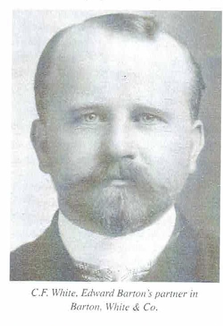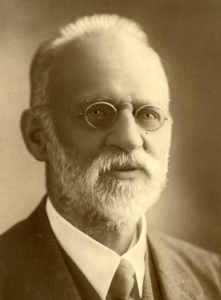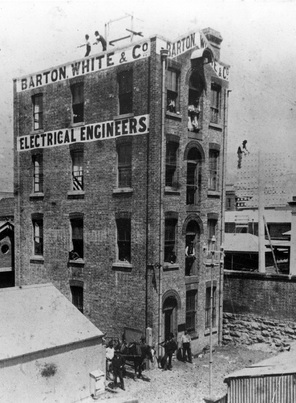

1880s Electric Memories
1882
Electric lighting was installed in Sutton’s Foundry in Adelaide Street, Brisbane.
In December, 1882 a large crowd gathered near Victoria Bridge, Brisbane to witness the first demonstration of public street lighting. Eight arc lamps were positioned between Eagle Street and Victoria Bridge. The lights were powered by a dynamo driven by a 10 h.p. steam-engine situated in Sutton’s Foundry. Several Queen Street shop windows were also lit by electric light as part of their Christmas decorations with power supplied from Sutton’s Foundry.

Barton, White & Company’s Powerhouse in Edison Lane, Brisbane, c.1889. The Company became the first to provide a public supply of electricity in Queensland.
1883
Alfred Shaw and Co. gained the contract to install and put on trial an electric lighting system in the Government Printing Office in 1883. Fifty incandescent lamps were installed in the Printing Office in William Street, Brisbane. Power was supplied by an 8.5 h.p. generator coupled to the steam-engine used for driving the printery machinery.
Brisbane’s tramways’ history is firmly linked to the city’s electrical heritage. The first trams in Brisbane were the horse-drawn trams of the Metropolitan Tramway and Investment Co. Ltd. The company was established in 1883 under the authority of the Tramways Act of 1882.
1884
The Brisbane Courier installed electric lighting in its composing room, using its own steam-engine-driven generators.
1886
Queensland Parliament House is lit by electricity. It is believed to be the first legislative building in the British Empire to have been illuminated with electricity. Supply came from the Government Printery Powerhouse via Edison Street Tubes along William Street. These tubes are probably the first underground cables in the Southern Hemisphere.
1888
The first public entity to receive electricity from the Barton, White & Co Powerhouse in Edison Lane, Brisbane, was the Post Office in 1888.
Edward Barton worked in the capacity of Government Engineer until February 1888, when he resigned to establish the firm of Barton, White and Company in partnership with C.F. White. It is claimed that the partnership played ‘a unique part in the history of the electricity supply industry in Queensland’.
One of the first projects undertaken by the new company in Brisbane was the installation of electric lighting to a roller-skating rink at the Exhibition Building. A fire destroyed the building in June 1888. However, the generating plant survived the fire and the partners actively looked for other ways to make use of the plant. The company gained the contract to provide electric lighting to replace the kerosene and gas lamps in the General Post Office. The supply was extended to incorporate nearby shops using a system of overhead wires. In this way, Barton, White and Co. became the first company to provide a public supply of electricity. Power was first generated from a shed, then a four-storey brick building in Edison Lane, formerly Telegraph Lane in Brisbane.
In addition to supplying electricity and installing plant, the company was involved in the manufacture of small electrical applications such as bells, fans, motors, telephones and speaking tubes, switches and fuses. Barton designed many of these and his detailed drawings can be seen within the pages of his Work Register (c.1890-c.1907) in Queensland Energy Museum’s archives.
One of the more novel applications of electricity came in the form of a penny-in-the-slot electric shock machine manufactured by Barton. The machines were installed in many of Brisbane’s hotels. Customers would insert a penny into the slot and hold the handles that were attached to the sides of the machine. The person holding the handles would experience a mild electric shock. The machines were eventually declared a hazard by the Government and withdrawn from service.
